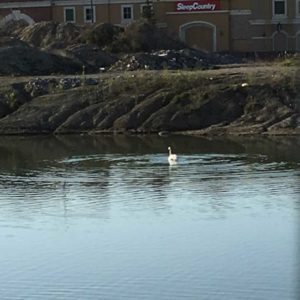
Very few neighbourhood issues become so infamous that they earn a nickname within the community, but that’s exactly what’s happened with the unfinished development site at 70 Wicksteed Avenue – or, as you may know it, Lake Leaside.
As the moniker suggests, Lake Leaside refers to a standing pool of water at a site that was originally intended to be developed into a shopping centre. Unfortunately, the discovery of soil contamination on site halted the development process midway and the site was left excavated but undeveloped. Runoff water and precipitation filled the excavated site shortly after, and Lake Leaside was born.
This spring, I met with the general manager of Toronto Water and the developer multiple times to accelerate the Short Term Discharge process so the site could be drained in time for the summer. While the drainage process was successfully initiated in June – several weeks ahead of schedule – it is only a matter of time before the site fills with water again and the process will have to be repeated.
While I’m pleased with the short-term progress we’ve made, I’m working closely with Toronto Building on a long-term, site-specific strategy to prevent future flooding events at Lake Leaside. Through a mechanism in the conditional permit issued for the site in 2014, we’ve directed the developer to restore the area to its pre-development condition, replace all vegetative matter, and restore prior drainage patterns to ensure the site does not flood again next year.
Throughout my time in office, reforming our planning and development process has been one of my top priorities. Lake Leaside clearly exhibits the need for a comprehensive review of the City’s bylaws regulating property standards and unfinished development sites. Developers should be required to remediate and fully restore construction sites, such as Lake Leaside, before they become a visual nuisance or health and safety concern in the community.
This month, the Planning and Housing Committee put forward updates intended to bridge the gaps among the Planning, Building, and Municipal Licensing and Standards (MLS) divisions. At committee and City Council, I will be advancing this strategy to improve our regulation of unfinished development sites and hold developers accountable to their project timelines through the use of fines, permit revocation, and other enforceable regulations.
Currently, while many new development applications include a targeted project completion date, there is often a significant gap of time between project approval and commencement of the construction process.
On sites where ongoing work is paused, building permits remain valid for up to six months under the Ontario Building Code, even if no progress is occurring. The grey area around stalled construction sites is compounded by a lack of enforceable regulations to ensure that proposed development timelines are adhered to.
As a result, commercial, industrial, and residential sites across the City can be left unfinished for years at a time, at no expense to the developer. The story of Lake Leaside demonstrates that we must take a strong stance on property regulations and utilize a multi-divisional, integrated approach during the transition from the planning to construction process.


